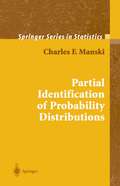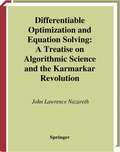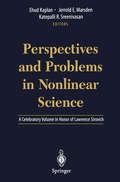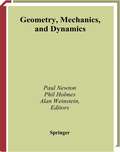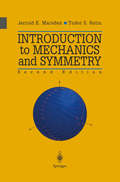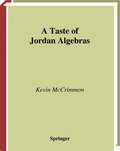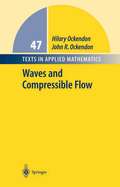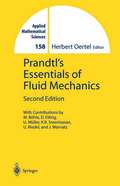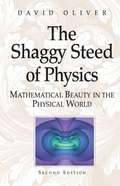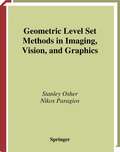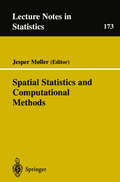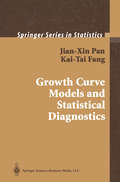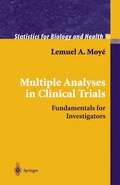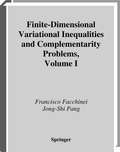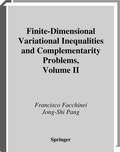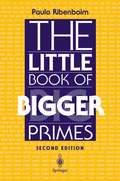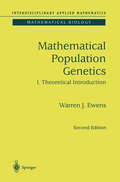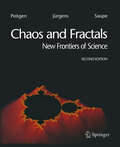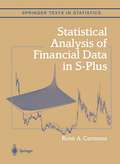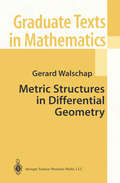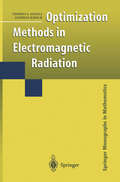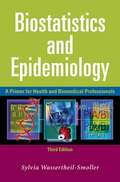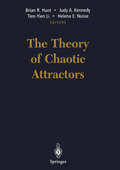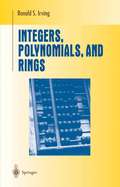- Table View
- List View
Partial Identification of Probability Distributions (Springer Series in Statistics)
by Charles F. ManskiThe book presents in a rigorous and thorough manner the main elements of Charles Manski's research on partial identification of probability distributions. The approach to inference that runs throughout the book is deliberately conservative and thoroughly nonparametric. There is an enormous scope for fruitful inference using data and assumptions that partially identify population parameters.
Differentiable Optimization and Equation Solving: A Treatise on Algorithmic Science and the Karmarkar Revolution (CMS Books in Mathematics)
by John L. NazarethAn overview of the dramatic reorganization in reaction to N. Karmakar’s seminal 1984 paper on algorithmic linear programming in the area of algorithmic differentiable optimization and equation-solving, or, more simply, algorithmic differentiable programming. Aimed at readers familiar with advanced calculus and numerical analysis.
Perspectives and Problems in Nonlinear Science: A Celebratory Volume in Honor of Lawrence Sirovich
by Ehud Kaplan Jerrold E. Marsden Katepalli R. SreenivasanLawrence Sirovich will turn seventy on March 1, 2003. Larry's academic life of over 45 years at the Courant Institute, Brown University, Rockefeller University and the Mount Sinai School of Medicine has touched many peo ple and several disciplines, from fluid dynamics to brain theory. His con tributions to the kinetic theory of gases, methods of applied mathematics, theoretical fluid dynamics, hydrodynamic turbulence, the biophysics of vi sion and the dynamics of neuronal populations, represent the creative work of an outstanding scholar who was stimulated mostly by insatiable curios ity. As a scientist, Larry has consistently offered fresh outlooks on classical and difficult subjects, and moved into new fields effortlessly. He delights in what he knows and does, and sets no artificial boundaries to the range of his inquiry. Among the more than fifty or so Ph. D. students and post docs that he has mentored, many continue to make first-rate contributions themselves and hold academic positions in the US and elsewhere. Larry's scientific collaborators are numerous and distinguished. Those of us who have known him well will agree that Larry's charm, above all, is his taste, wit, and grace under fire. Larry has contributed immensely to mathematics publishing. He be gan his career with Springer by founding the Applied Mathematical Sci ences series together with Fritz John and Joe LaSalle some 30 years ago. Later he co-founded the Texts in Applied Mathematics series and more re cently the Interdisciplinary Applied Mathematics series.
Geometry, Mechanics, and Dynamics: Volume in Honor of the 60th Birthday of J. E. Marsden
by Paul Newton Phil Holmes Alan WeinsteinJerry Marsden, one of the world’s pre-eminent mechanicians and applied mathematicians, celebrated his 60th birthday in August 2002. The event was marked by a workshop on “Geometry, Mechanics, and Dynamics”at the Fields Institute for Research in the Mathematical Sciences, of which he wasthefoundingDirector. Ratherthanmerelyproduceaconventionalp- ceedings, with relatively brief accounts of research and technical advances presented at the meeting, we wished to acknowledge Jerry’s in?uence as a teacher, a propagator of new ideas, and a mentor of young talent. Con- quently, starting in 1999, we sought to collect articles that might be used as entry points by students interested in ?elds that have been shaped by Jerry’s work. At the same time we hoped to give experts engrossed in their own technical niches an indication of the wonderful breadth and depth of their subjects as a whole. This book is an outcome of the e?orts of those who accepted our in- tations to contribute. It presents both survey and research articles in the several ?elds that represent the main themes of Jerry’s work, including elasticity and analysis, ?uid mechanics, dynamical systems theory, g- metric mechanics, geometric control theory, and relativity and quantum mechanics. The common thread running through this broad tapestry is the use of geometric methods that serve to unify diverse disciplines and bring a widevarietyofscientistsandmathematicianstogether,speakingalanguage which enhances dialogue and encourages cross-fertilization.
Introduction to Mechanics and Symmetry: A Basic Exposition of Classical Mechanical Systems (Texts in Applied Mathematics #17)
by Jerrold E. Marsden Tudor S. RatiuA development of the basic theory and applications of mechanics with an emphasis on the role of symmetry. The book includes numerous specific applications, making it beneficial to physicists and engineers. Specific examples and applications show how the theory works, backed by up-to-date techniques, all of which make the text accessible to a wide variety of readers, especially senior undergraduates and graduates in mathematics, physics and engineering. This second edition has been rewritten and updated for clarity throughout, with a major revamping and expansion of the exercises. Internet supplements containing additional material are also available.
A Taste of Jordan Algebras (Universitext)
by Kevin McCrimmonThis book describes the history of Jordan algebras and describes in full mathematical detail the recent structure theory for Jordan algebras of arbitrary dimension due to Efim Zel'manov. Jordan algebras crop up in many surprising settings, and find application to a variety of mathematical areas. No knowledge is required beyond standard first-year graduate algebra courses.
Waves and Compressible Flow (Texts in Applied Mathematics #47)
by Hilary Ockendon John R. OckendonThis book covers compressible flow however the authors also show how wave phenomena in electromagnetism and solid mechanics can be treated using similar mathematical methods. It caters to the needs of the modern student by providing the tools necessary for a mathematical analysis of most kinds of waves liable to be encountered in modern science and technology. At the same time emphasis is laid on the physical background and modeling that requires these tools.
Prandtl’s Essentials of Fluid Mechanics (Applied Mathematical Sciences #158)
by Herbert Oertel K. MayesThis book is an update and extension of the classic textbook by Ludwig Prandtl, Essentials of Fluid Mechanics. It is based on the 10th German edition with additional material included. Chapters on wing aerodynamics, heat transfer, and layered flows have been revised and extended, and there are new chapters on fluid mechanical instabilities and biomedical fluid mechanics. References to the literature have been kept to a minimum, and the extensive historical citations may be found by referring to previous editions. This book is aimed at science and engineering students who wish to attain an overview of the various branches of fluid mechanics. It will also be useful as a reference for researchers working in the field of fluid mechanics.
The Shaggy Steed of Physics: Mathematical Beauty in the Physical World
by David OliverThe Shaggy Steed is an unassuming figure from Irish folklore who reveals himself as an inspiring teacher of the forces hidden in the universe. This book celebrates an unassuming bit of physics that also turns out to be an inspiring teacher. The two-body problem - the motion of two bodies bound by the inverse-square force of gravity and electricity - is the Shaggy Steed of physics, guiding the reader to an understanding of both the forces and the mathematical beauty hidden in the physical world.
Geometric Level Set Methods in Imaging, Vision, and Graphics
by Stanley Osher Nikos ParagiosHere is, for the first time, a book that clearly explains and applies new level set methods to problems and applications in computer vision, graphics, and imaging. It is an essential compilation of survey chapters from the leading researchers in the field. The applications of the methods are emphasized.
Spatial Statistics and Computational Methods (Lecture Notes in Statistics #173)
by Jesper MøllerThis volume shows how sophisticated spatial statistical and computational methods apply to a range of problems of increasing importance for applications in science and technology. It introduces topics of current interest in spatial and computational statistics, which should be accessible to postgraduate students as well as to experienced statistical researchers.
Growth Curve Models and Statistical Diagnostics (Springer Series in Statistics)
by Jian-Xin Pan Kai-Tai FangThis book systematically introduces the theory of the GCM with particular emphasis on their multivariate statistical diagnostics, which are based mainly on recent developments made by the authors and their collaborators. Provided are complete proofs of theorems as well as practical data sets and MATLAB code.
Multiple Analyses in Clinical Trials: Fundamentals for Investigators (Statistics for Biology and Health)
by Lemuel A. MoyéConcentrating on the rationale for the analyses, the difficulties posed by their interpretation, easily understood solutions, and useful problem sets, this book will help clinical investigators understand multiple analysis procedures and key issues. It is written for advanced medical students, clinical investigators at all levels, research groups within the pharmaceutical industry, regulators at the local, state, and federal level, and biostatisticians.
Finite-Dimensional Variational Inequalities and Complementarity Problems (Springer Series in Operations Research and Financial Engineering)
by Francisco Facchinei Jong-Shi PangThis is part one of a two-volume work presenting a comprehensive treatment of the finite-dimensional variational inequality and complementarity problem. It covers the basic theory of finite dimensional variational inequalities and complementarity problems. Coverage includes abundant exercises as well as an extensive bibliography. The book will be an enduring reference on the subject and provide the foundation for its sustained growth.
Finite-Dimensional Variational Inequalities and Complementarity Problems (Springer Series in Operations Research and Financial Engineering)
by Francisco Facchinei Jong-Shi PangThis is part two of a two-volume work presenting a comprehensive treatment of the finite-dimensional variational inequality and complementarity problem. It details algorithms for solving finite dimensional variational inequalities and complementarity problems. Coverage includes abundant exercises as well as an extensive bibliography. The book will be an enduring reference on the subject and provide the foundation for its sustained growth.
The Little Book of Bigger Primes
by Paulo RibenboimA deep understanding of prime numbers is one of the great challenges in mathematics. In this new edition, fundamental theorems, challenging open problems, and the most recent computational records are presented in a language without secrets. The impressive wealth of material and references will make this book a favorite companion and a source of inspiration to all readers. Paulo Ribenboim is Professor Emeritus at Queen's University in Canada, Fellow of the Royal Society of Canada, and recipient of the George Pólya Award of the Mathematical Association of America. He is the author of 13 books and more than 150 research articles. From the reviews of the First Edition: Number Theory and mathematics as a whole will benefit from having such an accessible book exposing advanced material. There is no question that this book will succeed in exciting many new people to the beauty and fascination of prime numbers, and will probably bring more young people to research in these areas. (Andrew Granville, Zentralblatt)
Mathematical Population Genetics 1: Theoretical Introduction (Interdisciplinary Applied Mathematics #27)
by Warren J. EwensThis is the first of a planned two-volume work discussing the mathematical aspects of population genetics with an emphasis on evolutionary theory. This volume draws heavily from the author’s 1979 classic, but it has been revised and expanded to include recent topics which follow naturally from the treatment in the earlier edition, such as the theory of molecular population genetics.
Chaos and Fractals: New Frontiers of Science
by Heinz-Otto Peitgen Hartmut Jürgens Dietmar SaupeThe fourteen chapters of this book cover the central ideas and concepts of chaos and fractals as well as many related topics including: the Mandelbrot set, Julia sets, cellular automata, L-systems, percolation and strange attractors. This new edition has been thoroughly revised throughout. The appendices of the original edition were taken out since more recent publications cover this material in more depth. Instead of the focussed computer programs in BASIC, the authors provide 10 interactive JAVA-applets for this second edition.
Statistical Analysis of Financial Data in S-Plus (Springer Texts in Statistics)
by René CarmonaThis is the first book at the graduate textbook level to discuss analyzing financial data with S-PLUS. Its originality lies in the introduction of tools for the estimation and simulation of heavy tail distributions and copulas, the computation of measures of risk, and the principal component analysis of yield curves. The book is aimed at undergraduate students in financial engineering; master students in finance and MBA's, and to practitioners with financial data analysis concerns.
Metric Structures in Differential Geometry (Graduate Texts in Mathematics #224)
by Gerard WalschapThis book offers an introduction to the theory of differentiable manifolds and fiber bundles. It examines bundles from the point of view of metric differential geometry: Euclidean bundles, Riemannian connections, curvature, and Chern-Weil theory are discussed, including the Pontrjagin, Euler, and Chern characteristic classes of a vector bundle. These concepts are illustrated in detail for bundles over spheres.
Optimization Methods in Electromagnetic Radiation (Springer Monographs in Mathematics)
by Thomas S. Angell Andreas KirschThis book considers problems of optimization arising in the design of electromagnetic radiators and receivers, presenting a systematic general theory applicable to a wide class of structures. The theory is illustrated with examples, and indications of how the results can be applied to more complicated structures. The final chapter introduces techniques from multicriteria optimization in antenna design. References to mathematics and engineering literature guide readers through the necessary mathematical background.
Electronic Quantum Transport in Mesoscopic Semiconductor Structures (Springer Tracts in Modern Physics #192)
by Thomas IhnOpening with a brief historical account of electron transport from Ohm's law through transport in semiconductor nanostructures, this book discusses topics related to electronic quantum transport. The book is written for graduate students and researchers in the field of mesoscopic semiconductors or in semiconductor nanostructures. Highlights include review of the cryogenic scanning probe techniques applied to semiconductor nanostructures.
Biostatistics and Epidemiology: A Primer for Health and Biomedical Professionals
by Sylvia Wassertheil-SmollerFor the new edition of Biostatistics and Epidemiology, Dr. Wassertheil-Smoller has included several new chapters (genetic statistics, molecular epidemiology, scientific integrity and research ethics) and a new appendix on the basic concepts of genetics and a glossary of genetic terminology. She has also expanded the coverage of multi-center trials (an important aspect of implementation of the standards of evidence-based medicine), controversies in screening for prostate, colon, breast, and other cancers.
The Theory of Chaotic Attractors
by Brian R. Hunt Judy A. Kennedy Tien-Yien Li Helena E. NusseThe editors felt that the time was right for a book on an important topic, the history and development of the notions of chaotic attractors and their "natu ral" invariant measures. We wanted to bring together a coherent collection of readable, interesting, outstanding papers for detailed study and comparison. We hope that this book will allow serious graduate students to hold seminars to study how the research in this field developed. Limitation of space forced us painfully to exclude many excellent, relevant papers, and the resulting choice reflects the interests of the editors. Since James Alan Yorke was born August 3, 1941, we chose to have this book commemorate his sixtieth birthday, honoring his research in this field. The editors are four of his collaborators. We would particularly like to thank Achi Dosanjh (senior editor math ematics), Elizabeth Young (assistant editor mathematics), Joel Ariaratnam (mathematics editorial), and Yong-Soon Hwang (book production editor) from Springer Verlag in New York for their efforts in publishing this book.
Integers, Polynomials, and Rings: A Course in Algebra (Undergraduate Texts in Mathematics)
by Ronald S. IrvingThis book began life as a set of notes that I developed for a course at the University of Washington entitled Introduction to Modern Algebra for Tea- ers. Originally conceived as a text for future secondary-school mathematics teachers, it has developed into a book that could serve well as a text in an - dergraduatecourseinabstractalgebraoracoursedesignedasanintroduction to higher mathematics. This book di?ers from many undergraduate algebra texts in fundamental ways; the reasons lie in the book’s origin and the goals I set for the course. The course is a two-quarter sequence required of students intending to f- ?ll the requirements of the teacher preparation option for our B.A. degree in mathematics, or of the teacher preparation minor. It is required as well of those intending to matriculate in our university’s Master’s in Teaching p- gram for secondary mathematics teachers. This is the principal course they take involving abstraction and proof, and they come to it with perhaps as little background as a year of calculus and a quarter of linear algebra. The mathematical ability of the students varies widely, as does their level of ma- ematical interest.
